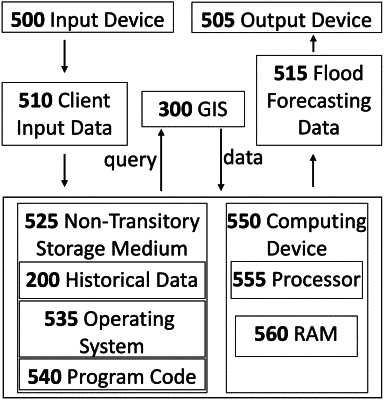| CPC G01W 1/10 (2013.01) [G06F 16/29 (2019.01); G01W 2201/00 (2013.01)] | 4 Claims |

|
3. A system for generating a predicting flooding likelihood in a given region over short to long term time intervals, comprising:
an input device;
an output device;
connection to a geographic information system;
at least one computing device which comprises at least one processor and random access memory; and
a non-transitory physical storage medium to store historical data, the operating system, and program code that, when executed by one or more computing devices, causes the one or more computing devices to:
obtain historical data from the region;
sample and structure the historical data in conjunction with geographic data queried from a geographic information system into a dataset which comprises a set of data instances, where each data instance comprises an input and a target;
divide the dataset into pre-processed training and validation partitions;
configure neural network and training hyperparameters for a neural network-based flood forecasting model, where the neural network used in the neural network-based flood forecasting model employs a modification of a contraction-expansion U-Net architecture, built with a set of layer types comprising convolutional, rectified linear, sigmoid, max pooling, up convolution, and concatenation layers, said modification being the addition of a concatenation layer that joins an input half resolution tensor to the foremost intermediate representation with depth 2 in the U-Net and a concatenation layer that joins an input quarter resolution tensor to the foremost intermediate representation with depth 3 in the U-Net;
train the neural network-based flood forecasting model on the pre-processed training partition;
perform validation on the neural network-based flood forecasting model with the pre-processed validation partition; and
generate a predicting flooding likelihood in given region over short to long term time intervals using the trained and validated neural network-based flood forecasting model.
|